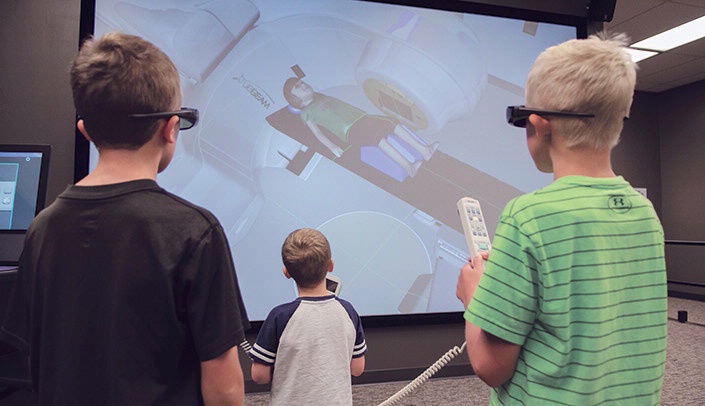Targeted radiation treatment and squirmy kids do not equal a good outcome.
Targeted radiation requires patients to remain motionless. The American Cancer Society says that up to 60 percent of cancer patients will receive radiation therapy as one form of treatment.
When those patients are kids, remaining motionless is a lot to ask, especially with the stress and anxiety that comes with an unfamiliar environment and “scary” equipment.
As a result, many of these kids undergo sedation – often with every appointment. This repeated anesthesia comes with higher medical costs and additional stress for the kids and their families,
as well as potential long-term risks.
That sparked an idea now being explored by UNMC’s radiation therapy program and its director, Lisa Bartenhagen. UNMC is all-in on using virtual-immersive reality and interactive technology to better train and educate health professionals. But what about using those same tools to help patients?
“Let’s use UNMC’s VERT (Virtual Environment Radiotherapy Training system) to help patients practice upcoming radiation-therapy procedures, just as we do with care providers,” she said.
Likened to a flight simulator, the VERT is a 3-D, “fully immersive” experience. UNMC’s model was acquired thanks to a partnership between the College of Allied Health Professions, the College of
Medicine and the department of radiation oncology.
UNMC has been a national leader in the use of the VERT as a teaching tool for care providers to simulate radiation therapy treatment Bartenhagen wondered if pediatric patients could similarly familiarize themselves with the equipment and the environment, even playing or “giving” loved ones or teddy bears radiation therapy, would it reduce their anxiety levels beforehand?
Could they even reduce or eliminate the need for anesthesia sedation?
If so, it would give patients a better quality of life, in being able to do regular activities – including eating – before and after treatment. It would give kids and their families one less hardship during a difficult time.
Bartenhagen and her co-investigators will launch a pilot study to scientifically test whether use of the VERT could reduce anxiety levels in pediatric cancer patients. If so, the use of pre-treatment simulation could be a model for oncology departments.
The prospective study is still forthcoming. But preliminary anecdotal results have been encouraging.
Collaborators, along with Bartenhagen, include UNMC’s primary clinical partner, Nebraska Medicine, including its Child Life Services; Chi Lin, M.D., Ph.D., associate professor of radiation oncology; Don Coulter, M.D., associate professor of pediatrics hematology/oncology; Rebecca Swanson, a nurse practitioner for Nebraska Medicine; and Jana Koth, assistant professor of medical imaging and therapeutic sciences.
